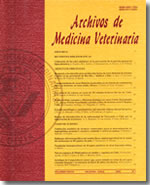Development and validation of an immunoassay for the detection of caprine leptin
Main Article Content
Abstract
Leptin is a protein hormone synthesised and secreted by white adipocytes. This hormone is involved in various metabolic processes, energy balance, fertility, inflammation and angiogenesis. In order to have a system for determining the concentration of leptin in goats, in this work we developed and validated an immunodiagnostic system (ELISA) using goat leptin obtained in recombinant form in Escherichia coli. Polyclonal antibodies were prepared in rabbits and a specific ELISA system was developed, then the binding capacity of the recombinant leptin specific to the receptor in the central nervous system was demonstrated by immunohistochemistry. Prior to the development of immunometric system, reagents were evaluated in a commercial RIA standardised system, and results indicated support for the evaluation system. The displacement curve of recombinant leptin showed no difference in the slope or the correlation coefficient with reference leptin, although the IC50 dose was lower. Binding capacity of the recombinant protein to specific receptors in the hypothalamus was identified. No significant differences in plasma concentrations of leptin obtained by ELISA and those obtained in the study using the RIA formulated for ruminants were obtained. These observations suggest that the developed ELISA could be an effective method for determining the concentration of goat serum leptin.

